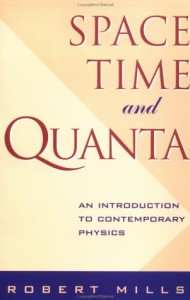Science Seen Physicist and Time One author Colin Gillespie helps you understand your world.
One Thing About All This . . .
We need a New Year’s Revolution. (No typo: Revolution with a v.) Last week I suggested that the Large Hadron Collider may find no superparticles and that this could lead to a big change in physics. Indeed a common theme in last year’s posts was the need to complete the Physics Revolution that began a hundred years ago. The world’s flagging economy could use the kind of boost that this will bring. So, is billion-dollar physics from the LHC the sole source for this revolution? Is there another way for it to happen? I think there is.
 That everything is made of many copies of a single thing is an old idea. It is the basis of a famous controversy in the 1700s. German philosopher Immanuel Kant calls such a thing a monad. But Kant’s hero, Swiss mathematician Leonhard Euler, says matter sits in infinitely divisible space. Thus matter must be infinitely divisible. So no monads! At the time Euler’s argument is a clear winner; and his math is central to physics to this day. But note that his argument assumes that space is infinitely divisible.
That everything is made of many copies of a single thing is an old idea. It is the basis of a famous controversy in the 1700s. German philosopher Immanuel Kant calls such a thing a monad. But Kant’s hero, Swiss mathematician Leonhard Euler, says matter sits in infinitely divisible space. Thus matter must be infinitely divisible. So no monads! At the time Euler’s argument is a clear winner; and his math is central to physics to this day. But note that his argument assumes that space is infinitely divisible.
Then and now, people see this as obvious. No big surprise. Hold out your hand. Clearly you can move it any distance that you choose. From infancy experience embeds this concept in our brains. Yet the controversy lingers. American philosopher Thomas Holden says:
When one hears of baroque scholars wrestling over the abstruse quandaries of infinite divisibility, the image conjured up can seem somewhat ridiculous. … But this should not lead us to dismiss the controversy.
Mathematicians have another name for infinite divisibility. They call it continuity. Its math forms the foundation for most of our physics. That’s why discontinuity—quantized space—offers us an opportunity to find new physics and complete the Revolution.
This idea too is not exactly new. Yet few physicists are working on it. Why? Some say it’s because space quanta must be Planck-sized, so tiny they are far beyond the reach of any possible successor to the LHC. Though this is true I think the main reason is discontinuous space needs new math that is entirely different from the math a million physicists were taught in school. About a hundred years ago Albert Einstein worked on the physics of discontinuity. He wanted to ban the continuum. He saw the need for new math:
But we still lack the mathematical structure unfortunately. How much I have already plagued myself this way!
American scientist and engineer Carver Mead sees the need in larger terms …
… a way of thinking about the universe vastly more intuitive and inspiring than what we have today. We have been living with misconceptions and gobbledygook, with thought processes not allowed to go forward. … Our view of science, that got us this far, is keeping us from going further. There’s a bigger conceptual picture we need to integrate into our thinking.
We’ve been waiting for that big conceptual picture for a hundred years. So here’s a New Year’s Revolution: Let’s figure out the physics of quantized space.
Coming: Did Einstein take a wrong turn?
Sources:
Thomas Holden (2004), The Architecture of Matter: Galileo to Kant, New York: Oxford University Press, p. 6; http://www.scribd.com/doc/217400251/Thomas-Holden-the-Architecture-of-Matter-Galileo-to-Kant#scribd
Albert Einstein (1917), letter to Walter Dällenbach, in The Collected Papers of Albert Einstein, Ann Hentschel (tr.), Princeton: Princeton University Press, vol. 8, p. 286; see also, Sabine Hossenfelder (2010), “Einstein on the discreteness of space-time”, http://backreaction.blogspot.ca/2010/10/einstein-on-discretenes-of-space-time.html
Carver Mead (2013), speech to 60th International Solid State Circuits Conference, San Francisco, 19 February; see Rick Merritt (2013), “Carver Mead: Finish the Physics Revolution”, EE Times, New York: UBM Tech, http://www.eetimes.com/document.asp?doc_id=1263068
Other Reading:
Martin Schönfeld (2005), “Superstrings and the Euler-Kant Mirror: Deconstructing Kant’s Debut”, NCCU Philosophical Journal, Taipei City: National Chengchi University, p. 97, esp. pp. 109 – 117; http://oldthinker.nccu.edu.tw/new_paper/paper001/13-5Schoufeld.pdf
George Johnson (1999), “How Is the Universe Built? Grain by Grain”, The New York Times, December 7; http://faculty.washington.edu/smcohen/320/GrainySpace.html
Colin Gillespie (2013), Time One: Discover How the Universe Began, New York: RosettaBooks, p. 393, http://www.rosettabooks.com/book/time-one/; “Almost an Ansatz”, http://www.timeone.ca/chapters/almost-an-ansatz.pdf
Image Source: Robert Mills (1994), Space, Time and Quanta, New York: W.H. Freedman, cover; http://www.amazon.com/Space-Time-Quanta-Robert-Mills/dp/0716724367

No comments yet.